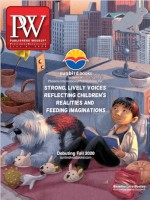While much of the picture regarding the performance of publishers’ digital resources during the pandemic is rosy, Britten Follett, executive v-p of Follett School Solutions, points out that making the pivot to distance learning has not been seamless, largely due to longstanding equity issues across the country. “I’m hearing daily from our customers, parents, and students about the challenges associated with delivering remote learning,” she says. “I recently spoke with a member of the North Carolina Department of Public Instruction, who shared that they are no longer calling the delivery of instruction to students at home ‘eLearning’ because there are tens of thousands of students in the state who do not have internet connectivity.”
One way that publishers and education companies can help mitigate this digital divide is to continue to spotlight print books and make them accessible. “The equity piece of distance learning is a real issue and, frankly, print has a major role to play in addressing that,” says Amy Cox, associate v-p of marketing at Capstone. “Content can’t all be just digital. It’s been exciting to be a part of helping educators innovate to get print in the hands of their students. For example, we helped Chicago Public Schools provide take-home book bundles to families who were coming to their food distribution sites. Actually, this particular example provided us with some unique challenges, including getting book shipments accepted at closed school buildings. Our local sales representative ended up taking in 20 school sites’-worth of books in her garage and then delivering them to the appropriate sites.”
Follett believes “a blend of print and digital content is absolutely critical.” To that end, she adds, “We’ve seen rural communities offer drive-through libraries where students can check a print book out via Follett Destiny and pick it up from the school. Also, several urban districts have purchased tens of thousands of copies of popular titles to distribute grab-and-go style with students’ lunches in sacks and backpacks to ensure every child has resources at home. Our team of teachers and librarians at Follett is building on the grab-and-go concept by curating custom collections based on the school or district’s curricular objectives.”
Mackin focuses on a blended approach as well and is seeing an uptick in print sales. “Our customers count on us to deliver the highest quality print and digital materials,” Troy Mikell, director of marketing and advertising, says. “While print orders trailed off in the initial weeks of the shelter-in-place mandates, our customers—and their schools and districts—have resumed placing critical book orders for titles that they anticipate they will need for fall 2020,” Mikell says.
At Scholastic, Lauren Tarshis, senior v-p and editor-in-chief/publisher of Scholastic classroom magazines, says that the company is “still committed to bringing print books and magazines into students’ hands because we know how important that connection to the physical page can be for engaging kids. We know from the Scholastic Kids & Family Reading Report that more than two-thirds of kids agree they will always want books printed on paper.” Tarshis cites a recent example out of Connecticut, noting that the Scholastic Education group partnered with Governor Ned Lamont and the state department of education to deliver more than 185,000 take-home book packs to kids in grades K–8 throughout the state. “Our book clubs and book fairs are also being creative nationwide in supporting educators and families to gain books through digital flyers and virtual book fairs,” Tarshis adds. “Educators are sharing with us their inventive ways of ensuring that books, as well as our magazines, make it to kids, from delivery with school lunches to book drive-throughs, and even the personal, socially distanced drop-off.”
Physical books always take center stage at Simon & Schuster Children’s Publishing, according to Lauren Hoffman, v-p and director of marketing and publicity. “Everything we do is in support of our print books,” she says. “All of our recent digital efforts were launched in order to aid in discoverability and enhance the educational/entertainment experience and further engage readers in our print books.” She mentions some of the things her team has been doing to keep print books at the forefront. “We continue to work with bookstores and other venues across the country to host virtual events and school visits with our authors and illustrators, offering signed bookplates, when requested, to incentivize sales,” she says. “With virtual author events now a major aspect of our business, we are keeping readers and fans apprised of events via the Simon & Schuster Author Events page. It’s a one-stop shop for all author events taking place on Facebook, Zoom, YouTube, and other digital platforms, and can be browsed by week or month, filtered by adult, kids or teen, and looked at in calendar view or for single event information.”
Adrienne Waintraub, executive director of school and library marketing at Random House Children’s Books, says that although digital teaching materials have received more emphasis recently, “we are still very much focused on promoting our backlist and frontlist titles, so that teachers and educators are able to incorporate them into their virtual curriculum.”
And Rachel Benoit, director of marketing at Nomad Books, describes another way that digital and print have been working nicely together of late. “Because we sell books directly to customers at our online store, we aren’t reliant on larger digital retailers to get our books shipped in a timely manner,” she says. “We find that customers get a taste of what we have to offer through our free, downloadable resources, and then they want the whole package, so they return and buy the books."



 Volume 267
Issue 23
06/08/2020
Volume 267
Issue 23
06/08/2020





